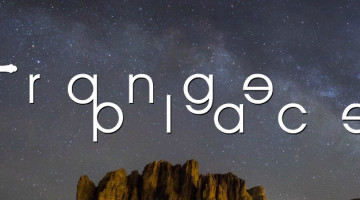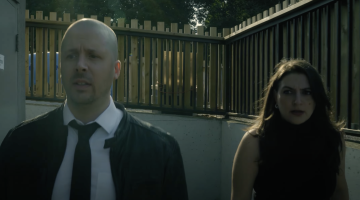It’s been said that variety is the spice of life, and the same goes for the daily occurrences that take place throughout our lives. Whether it’s mundane, peculiar, or absolutely unbelievable, those events often make for great stories. Now streaming on its official web site , the award-winning THE MUTE SERIES proves that truth in an entertaining, ongoing collection of short films that shine a fascinating spotlight on life itself.
Created and directed by Andy Lambert, and using a unique production style that manages to take full advantage of what would otherwise be stifling limitations for any filmmaker (no spoken dialogue, camera movement or multiple shots), the 12 films that so far constitute THE MUTE SERIES let viewers be a virtual “fly on the wall” as they witness a wide range of funny, suspenseful and touching moments.

“Sound Sleeper”, one of 12 short films that are part of THE MUTE SERIES, created and directed by Andy Lambert, and now streaming on its official web site @ muteseries.com.
While THE MUTE SERIES’ main method of distribution is the Internet, Lambert says that his project is one that, unlike many web series or short films, won’t transform into a larger scale production.
Furthermore, since life always moves fast, since technology is in a constant state of flux, and since finding time to enjoy entertainment on a busy schedule is always difficult, Lambert believes that THE MUTE SERIES distinctively reflects those realities.
“The films are not really short films (they’re too short, and besides, they work better as a group) and the series is not trying to be a mini TV series. It’s not a pilot for a movie and it’s not even a calling card,” Lambert explains. “It’s just something that exists because it can in the situation we are in now. There’s no way I would have made this series in a pre-Internet world. So, for me, it’s interesting to think of how new forms of filmmaking might exist rather than just doing something to get somewhere else (i.e., onto mainstream TV).”
In addition to the 8 short films (running 1-2 minutes on average) that previously debuted as part of THE MUTE SERIES, 4 new entries premiered on October 17th. Viewers already familiar with the fascinating and often offbeat situations found in the series’ past entries can expect more of the same in this newest batch, as Lambert describes each of the four shorts.
“One (‘Wait For It’) looks at the group psychology of queuing, another (‘Dress Code’) at the problems of retaining one’s dignity when changing on the beach, and another (‘The Late Man’) features a man who gets to a funeral just in time to say goodbye,” he says. “Probably the most surreal one is ‘The Crush’, which is a tale of two cardboard boxes that fall In love!”
Aside from his work on THE MUTE SERIES, Lambert spends a majority of his time directing TV commercials for various clients. Yet, it was on the set of one such advertisement that the concept for what would be the first film in Lambert’s newest project came together in unexpected fashion.
“I was on a shoot in which the schedule got messed around, meaning that the last day was going to end early,” says Lambert. “Knowing that I would have a cast and crew on the clock for an hour or so, I started plotting to make a quick short film — it would have been a terrible shame to waste this rare opportunity! Everyone thought I was joking, but I pushed ahead regardless.”

“Tuba, Or Not Tuba?” One of 12 short films in THE MUTE SERIES, an award-winning, continuous collection of short films created and directed by Andy Lambert.
From there, accident turned into inspiration for Lambert as production began on THE MUTE SERIES’ first entry, “Tuba, Or Not Tuba”. “The most interesting – and comic – prop we had on that day was a sousaphone tuba, so I came up with an idea based around that,” he explains. “We didn’t have any sound recordist on the shoot, so I knew I couldn’t have any dialogue.”
That shoot would also provide Lambert with one of the most critical components of what would eventually become part of THE MUTE SERIES’ signature production method. “The dolly grip had been wrapped early, so I couldn’t move the camera,” Lambert adds. “I spent most of the hour available to me coming up with the script, so I didn’t have enough time to do any more than one shot.”
As if that weren’t enough, Lambert’s next commercial production saw another unexpected schedule opening. This time, the resources and talent he had at his disposal were larger, and the innovative style that he would implement throughout each shoot of THE MUTE SERIES would begin to take shape.
“I had a cast of 50 extras dressed in yellow, so I created a scenario based around them. Once again, there was no sound recordist and so there was no chance to have any dialogue. As before, it ended up as a single, static shot. Suddenly, I had two micro-length films in the bag that were very similar in style. And that’s when I realized I was onto something. The limitations I faced in making these two shorts were something to be welcomed.”
As mentioned earlier, Lambert structured the production of each short film in THE MUTE SERIES around three simple, yet rigid rules: no dialogue, no camera movement, and no multiple shots. As was the case on both shoots, what would otherwise have been a complicated situation for any other filmmaker became an incredible opportunity for Lambert to work within a remarkable production style all his own.
“I realized I had the potential to make a series based on these restrictions. The rules would force me to be more creative and give the whole series a very distinct and striking aesthetic. And so, that’s what I did,” Lambert explains. “I’ve shot ten more films since then, thankfully with a bit more preparation than the first two, which were essentially improvised with what we had at hand.”

A scene from “Dress Code”, another memorable entry in THE MUTE SERIES.
As Lambert, his actors and a small production crew would learn to make creative use of the production boundaries set forth in THE MUTE SERIES, the show’s creator/director would also find new ideas for stories from his own personal experiences.
“I’ve been finding inspiration in a variety of things. It might be my own observations of myself falling asleep in front of the TV (“Sound Sleeper”), or it might be watching people going to great lengths to make sure no one can see them when they’re changing on the beach (“Dress Code”).”
Since the actions of each character are captured in one single shot throughout each film in THE MUTE SERIES, and since their words are not part of the soundtrack, actors who’ve worked with Lambert say that they feel at ease when they see the final cut for themselves. In fact, Lambert says, those performers have also embraced the opportunity of acting solely through physical movements.
“I think actors really like being in MUTE films, as they know I’m not going to mess with their performance through editing,” Lambert responds. “I think they also feel that the lack of dialogue is a great back-to-basics challenge. They possibly have to do a little bit of extra work to help tell the story, but the trick is to do this while keeping things subtle and believable.”
While Lambert relied on the kindness and talents of family and friends to get his first series of films off the ground, this latest collection of shorts in THE MUTE SERIES features an increased level of production thanks to London-based co-producers 76 Ltd., which also happens to be the company that represents him for directing TV commercials. In addition to his off-camera crew, Lambert works closely with his actors, soliciting their input and suggestions to make each shoot even more successful.
“In a funny sort of way, because the entire cast is by necessity involved in the one and only shot of the film, the actors feel more like creative collaborators in the whole project, and (they) become quite excited, offering up ideas. So far, all the cast members I’ve used have done a great job and it’s been a joy to work with them.” During one shoot, as Lambert remembers, he suddenly became the star of the show. “For one film, “The Searchers”, I even had to resort to casting myself, and I’ve never acted before!”

A young soccer goalkeeper takes in the sights and sounds of a day on the pitch in THE MUTE SERIES short “Goal Attainment”.
With each film in THE MUTE SERIES presented in a single, unmoving shot, it can be often be difficult for Lambert to convey the amount of plot information that’s critical to understanding the visual situations presented therein, and to accelerating the progress of each story. Nonetheless, this approach does come with some notable advantages, while adding to the dramatic and comedic aspects of the films themselves.
“For instance, there’s a lot of characters entering and exiting frames, and that has a bearing on the pace of things,” Lambert says, describing the one shot aesthetic employed in THE MUTE SERIES. “Although they’re short, the films have a ‘slow burn’ quality about them, which you have to embrace. For me, this adds to their humor and charm. It does make it tricky to predict how long the final films will be, but so far they’ve all come in at around 1½ – 2 minutes long.”
In addition to telling his stories through striking visuals and physical movements by his actors, Lambert creatively uses sound to add further impact to the visuals in each film. Even though there’s no incidental music score to punctuate key moments in the films themselves, ambient sounds are just as critical to the effectiveness of each entry in THE MUTE SERIES.
“In ‘Goal Attainment’, the presence of the other 21 football players (and indeed the spectators) are entirely created by sound, as is the presence of some incongruous urban seagulls,” he says. “‘Auto Exposure’ has a more surreal soundscape that suggests a nearby train station or bridge that helps to build up tension, and a sense of menace. The gag in “Sound Sleeper” is very dependent on the sound from the off-screen TV.”
Even though Lambert doesn’t necessarily advise future web series creators who might be inspired by his production style for THE MUTE SERIES to replicate the boundaries he worked under for their own projects, he does find that filming within creative limits can lead to some remarkable results.

Snapshot from “Auto Exposure”, another entry in THE MUTE SERIES, created and directed by Andy Lambert.
“By embracing conceptual restrictions, one can turn the whole ‘the budget is the aesthetic’ approach to your advantage and make it something more distinct and unusual,” he says, citing one such example of how working within such limitations helped inform the approach of one of his main filmmaking inspirations.
“I recall reading that (director) Jim Jarmusch often used to give himself little rules by which he made his films. It’s obvious when you look at STRANGER THAN PARADISE which only has one shot per scene, followed by a few seconds of black. I think in DOWN BY LAW, for instance, he only allowed the camera to move if an actor moved. In general, I think that in art, restrictions can be liberating!
Just as life is filled with moments of laughter, sadness and intensity, THE MUTE SERIES captures that unending variety of experiences in a powerful and memorable way. Summing up what viewers can expect to find in the growing collection of shorts that make up the series, Lambert says that every film, like life itself, has something for just about everyone.
“THE MUTE SERIES casts a dispassionate and mordant eye over various traits of modern life — greed, conformity, sloth, indifference, control, cruelty — and tries to see the funny side! We live in an absurd world full of irrational pursuits, but also strange comforts. What could be more amusing than that?”
(Note: Regarding closed-captioning/subtitling of the series, Lambert says: “There aren’t any plans to do that at the moment, but that’s because it hadn’t occurred to me. I think it’s a great idea. I’m going to look into closed captions as soon as possible.”)
ON THE WEB: http://www.muteseries.com/










No Comment